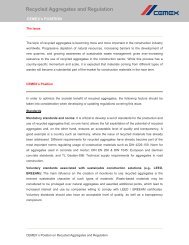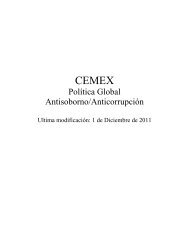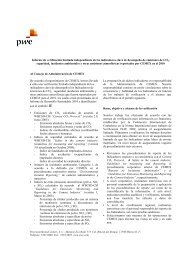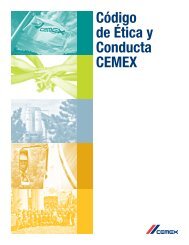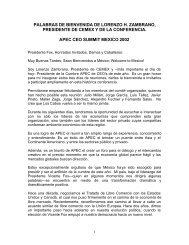building a STRONGER foundation - Cemex
building a STRONGER foundation - Cemex
building a STRONGER foundation - Cemex
Create successful ePaper yourself
Turn your PDF publications into a flip-book with our unique Google optimized e-Paper software.
Critical Accounting Policies<br />
Identified below are the accounting policies we have applied under MFRS that are critical to understanding our overall financial<br />
reporting.<br />
Income Taxes<br />
Our operations are subject to taxation in many different jurisdictions throughout the world. Under MFRS, we recognize deferred<br />
tax assets and liabilities using a balance sheet methodology, which requires a determination of the temporary differences between the<br />
financial statements carrying amounts and the tax basis of assets and liabilities. Our worldwide tax position is highly complex and<br />
subject to numerous laws that require interpretation and application and that are not consistent among the countries in which we<br />
operate. Significant judgment is required to appropriately assess the amounts of tax assets and liabilities. We record tax assets when<br />
we believe that the recoverability of the asset is determined to be more likely than not in accordance with established accounting<br />
principles. If this determination cannot be made, a valuation allowance is established to reduce the carrying value of the asset.<br />
For the recognition of deferred tax assets derived from net operating losses and their corresponding valuation reserve, we make<br />
an assessment of:<br />
(a) the aggregate amount of self-determined tax loss carryforwards included in our income tax returns in each country that we<br />
consider the tax authorities would not reject based on available evidence; and<br />
(b) the likelihood of the recoverability of such tax loss carryforwards prior to their expiration through an analysis of estimated<br />
future taxable income.<br />
If we consider that it is more likely than not that the tax authorities would reject a self-determined deferred tax asset, we would<br />
decrease its deferred tax assets. Likewise, if we consider that we would not be able to use a deferred tax carryforward asset before its<br />
expiration, we would increase our valuation reserve. Both situations would result in additional income tax expense in the statement of<br />
operations for the period in which such determination is made.<br />
We consider all available positive and negative evidence, including factors such as market conditions, industry analysis, our<br />
expansion plans, projected taxable income, carryforward periods, current tax structure, potential changes or adjustments in tax<br />
structure, tax planning strategies, future reversals of existing temporary differences, etc., in the determination of whether it is more<br />
likely than not that such deferred tax assets will ultimately be realized.<br />
Every reporting period, we analyze our actual results versus our estimates and adjust our tax asset valuations as necessary. If<br />
actual results vary from our estimates, the deferred tax asset and/or valuations may be affected and necessary adjustments will be<br />
made based on relevant information. Any adjustments recorded will affect our net income in such period.<br />
Our overall strategy is to structure our worldwide operations to minimize or defer the payment of income taxes on a<br />
consolidated basis. Many of the activities we undertake in pursuing this tax reduction strategy are highly complex and involve<br />
interpretations of tax laws and regulations in multiple jurisdictions and are subject to review by the relevant taxing authorities. It is<br />
possible that the taxing authorities could challenge our application of these regulations to our operations and transactions. The taxing<br />
authorities have in the past challenged interpretations that we have made and have assessed additional taxes. Although we have from<br />
time to time paid some of these additional assessments, in general we believe that these assessments have not been material and that<br />
we have been successful in sustaining our positions. No assurance can be given, however, that we will continue to be as successful as<br />
we have been in the past or that pending appeals of current tax assessments will be judged in our favor.<br />
Foreign currency translation<br />
Under MFRS, concurrent with the use of nominal amounts during low-inflation periods, beginning January 1, 2008, the<br />
translation of foreign currency financial statements into Mexican Pesos is made using the foreign exchange rate at the end of the<br />
corresponding reporting period for balance sheet and the exchange rates at the end of each month for the income statement accounts.<br />
For subsidiaries operating in high-inflation environments, the financial statements are first restated into constant amounts in their<br />
functional currency, and then translated into Mexican Pesos using the exchange rate at the reporting date for balance sheet and income<br />
statement accounts.<br />
Derivative financial instruments<br />
In compliance with the guidelines established by our risk management committee and the restrictions in our debt agreements,<br />
we use derivative financial instruments such as interest rate and currency swaps, currency and stock forward contracts, and other<br />
instruments, in order to change the risk profile associated with changes in interest rates, the foreign exchange rates of debt agreements,<br />
or both, as an alternative source of financing, and as hedges of: (i) highly probable forecasted transactions and (ii) our net assets in<br />
80



